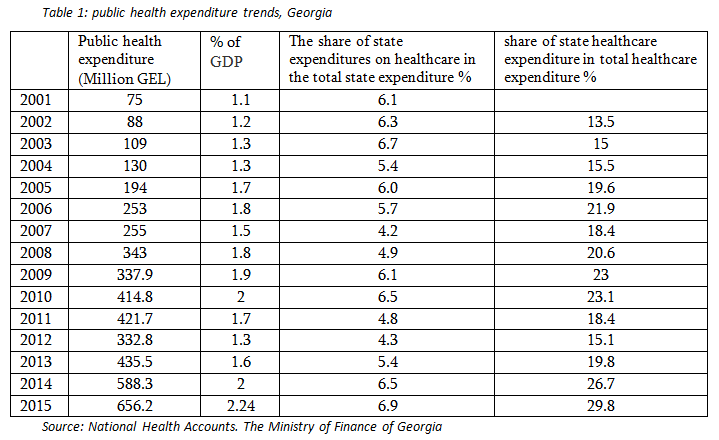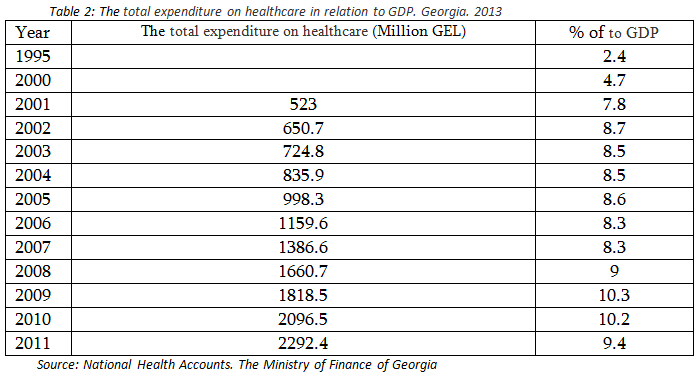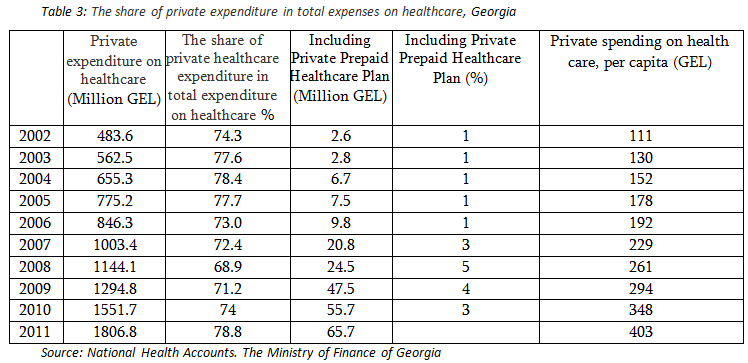


Author: Tengiz Verulava (Doctor of Medicine, Professor at Ilia State University)
 The article was writen in the framework of the project "Strategic Plan Georgia 2020 - Strengthening Public Involvement" and was published on the blog "Georgia 2020".
The article was writen in the framework of the project "Strategic Plan Georgia 2020 - Strengthening Public Involvement" and was published on the blog "Georgia 2020".
In recent years, part of the society in Georgia has been critical toward the increase in the state health care expenditures, considering it to be a heavy burden on the small state budget (Lagazidze 2015), or that “the social direction of the budget decreases the capital costs of the government, that hinders the economic growth of the country” (Kukava 2014).
The aim of the article is to assess whether the critical claims about the expenditures of state on the healthcare system are valid, as well as determine if there exists any type of standard measurement, or recommendation on how much the state should spend on healthcare, considering the economic capacity of the country?
Evidently, a country with low economic gains, which could be considered poor, cannot spend excessively on healthcare. However, the research has shown, that despite the growing expenses on healthcare, Georgia still lags behind not only the standards set by the World Health Organization (WHO), but also many low-income states.
This assessment was made by the World Health Organization based on the indicators of the effectiveness of the funding of the system, as well as the comparative analysis of the statistical data of other countries (developed and developing ones). Therefore, the article discusses the internationally acknowledged indicators to assess the funding of Georgia’s healthcare system:
The share of state expenditures on healthcare in the total state expenditure shows the government’s approach toward health care sector. and illustrates the importance of the healthcare expenditure compared to other sectors of economy.
One of the main values of the state is individual’s health. The obligations taken by the government in the health care system has a significant impact on individual’s health. According to the statistical data, state funds (33%) comprised the major source of health care expenditure in the world, while the compulsory social protection was 26%, private funds and insurance deposits together was smaller portion (18% and 19% respectively).
The share of state expenses in financing of the healthcare system depends on numerous factors, the most important being – values of the society, priorities, political will, the state of economic development of a country and budget capacity.
In many countries, bigger the GDP, bigger is the state’s share in healthcare fund. In these states, the health care system is developed on the principle of social solidarity and most of the costs are covered by the government via state and social insurance programs.
Research shows that, higher the health care costs, more affordable is the medical services, increasing the health indicator of the population (Getzen 2012). The concept of “better health” is wide and includes the increase in life expectancy, improvement in the quality of life, decreasing the number of death due to illness and reducing morbidity, improving the ability to function independently in chronically ill people. In countries, where the state expenditure on health care system is low, the burden of morbidity is high. In rich countries, where the state health care expenditure is 87% of global health care expenditures, the global morbidity level is low. For comparison, in poor countries global morbidity burden is 90% while the state healthcare expenditure is 13% (Getzen 2012).
However, it is important to note that growth in state expenditure on health is not the main aim of the policy of financing the healthcare system. Such growth can be justified only if we get a more cost-effective approach as a result and the healthcare system will achieve its aims more efficiently. There are many ways of using the existing resources cost-effectively, most important being a functional primary healthcare system, access to preventive services, which cost much less than treatment of illnesses, employing prospective methods of financing healthcare services, existence of financing strategy (competitive insurance model, introduction of methods of service utilisation management, participation of the patient in costs of certain areas of medical services…).
According to the World Health Organization, the state healthcare expenditures should comprise 15% of total state expenditure (Organisation of African Unity, 2001). In Georgia, despite the growth of state healthcare expenditure, its share in the state budget is relatively low (6.9%). This is almost twice as low as the indicator of WHO.
In Europe, the share of state healthcare expenditures in total state expenditure is between 4% and 20% (World Health Report 2010). Its important to note that prioritizing healthcare costs increases with increasing the state income. However, despite low income, some of the government tries to allocate higher costs in healthcare sector; meanwhile, in some of the richer states, governments try to spend less on healthcare (World Health Report 2010). Despite the fact that the state obligations toward the healthcare system increases with the growing state income, some of the low-income states spends more on it compared to the high-income counterparts (World Health Report 2010). According to the 2007 indicators, the share of healthcare costs was 10% of the state budget in 22 low-income states, while the same indicator was less than 10% in 11 high-income states (World Health Organization 2010).
As shown in the graph below (Graph 1), the share of health care costs in the state budget and is much lower than the indicators in Armenia (7.9%), Kazakhstan (10.9%), Ukraine (12.2%), Kyrgyzstan (13.2%), Belarus (13.5). In some countries, healthcare is not the priority of the budgetary policy due to number of reasons. Most importantly the reasons are financial and political. More specifically, the government considers the healthcare field to be economically ineffective. On the contrary, some of the governments is interested to have healthy population.
The next indicator of financing healthcare is the share of state healthcare expenditure in total healthcare expenditure. Total expenditure on health includes, both private and state expenses. According to WHO recommendations, state expenditures on health should represent more than 40% in total healthcare expenditures. Countries where this indicator is below 40% are considered to be states with limited engagement in healthcare problems. State expenditures on health care in Georgia represents 29,8% of the total expenses on healthcare, thus Georgia is far below the recommended threshold of the WHO.
As the graph (Graph 2) below indicates, compared to Georgia, the threshold set by the recommendations of the WHO is overcome by the countries such as Armenia (41.7%), Kazakhstan (53.1%), Ukraine (54.5%), Kyrgyzstan (59%).
The next important indicator is state expenditures on health care in relation to GDP. According to WHO recommendations the share of state healthcare expenditures in relation to GDP should be at least 5%.
In Georgia, despite the significant growth in state expenditures on health care, its share in relation to GDP is rather low (2,2%). As shown in the chart below (Chart 3), state expenditure-to-GDP ratio in low-income states is at around 2%, however, Georgia is behind countries such as – Kazakhstan (2,3%), Kyrgyzstan (3,9%), Belarus (4%), Ukraine (4,2%) (The World Bank 2015).
The total healthcare expenditure in relation to GDP is the best standard measure for social welfare and varies between 1% and 17% in different countries.
In Georgia, the total expenditure on healthcare in relation to GDP is equal to the same indicator in Europe. According to the 2011 data, it is 9.4%. This is the illustration, that Georgia spends almost same amount on the healthcare as do the European states. High share of healthcare costs in GDP might be due to high prices on medicines and therefore high medical inflation, the prevalence of increase in chronic illness due to growing aging population (MOH 2013).
The above mentioned shows that a significant share of healthcare expenses in Georgia falls on private expenses of citizens (at around 65%), which implies that healthcare is not a priority for the government. In terms of the share of private healthcare expenditure in total expenditure on healthcare, Georgia stands among countries such as – Sudan (75,8%), Yemen (74%), Afghanistan (73,8%), Azerbaijan (71,1%), Nigeria (69,3%), Myanmar (68,2%), Venezuela (65,8%). Consequently, many Georgian families are forced to deny themselves the aforementioned services as the cannot afford them.

Hence, the research confirms that the arguments against the increase of healthcare costs in Georgia are groundless. Georgia’s budget can’t be labeled as socially oriented. Despite the fact that the state’s role healthcare expenditure increases year by year, Georgia still lags behind not only the threshold recommended by the WHO, but also the indicators of low-income, poor states. Therefore, population has to cover a significant portion of medical service costs.
Bibliography:
The ideas expressed in the article belong to the author only and do not represent the position of IDFI, the University of Bremen or the Federal Foreign Office of Germany. Therefore, these organisations are not responsible for the content of the article.